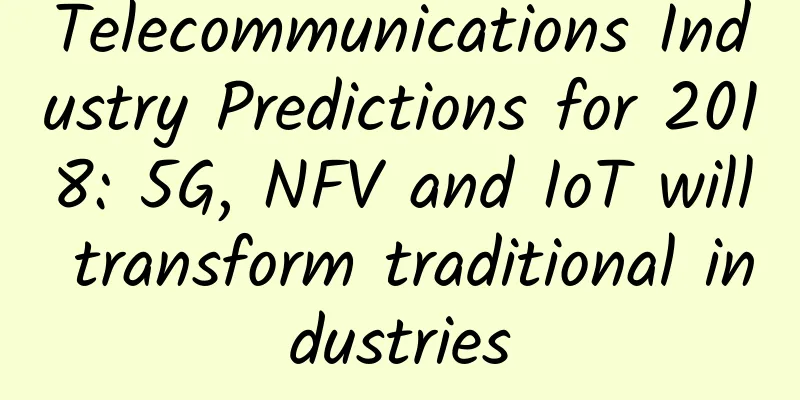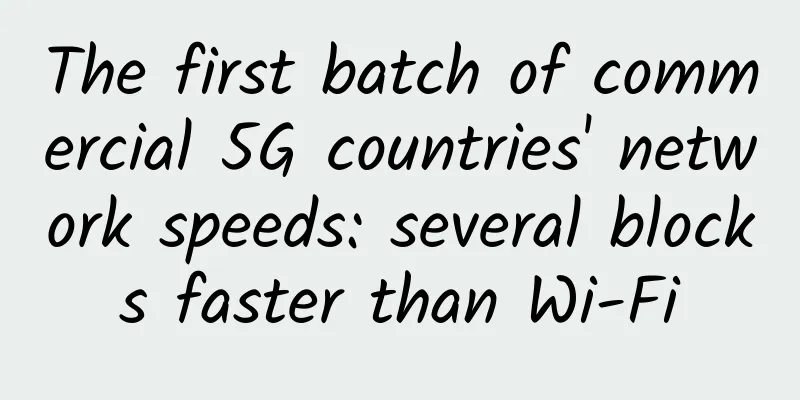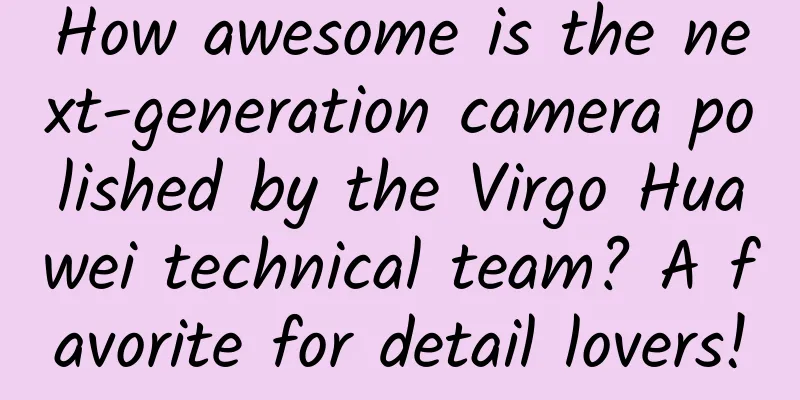Telecommunications Industry Predictions for 2018: 5G, NFV and IoT will transform traditional industries

|
As we all know, the telecommunications industry, in the form of service providers and infrastructure suppliers, has been driving the way forward, driving the networks, driving the standards, and driving the networks that users see and can use. But over the past 10 years, this has been changing: today’s networks are data pipes, and the drivers of today’s industry can be considered users, and at best, user interfaces, i.e., applications and devices.
Therefore, Jim Machi, senior vice president of product management and marketing at Dialogic, made a prediction for the telecommunications market in 2018: The telecommunications industry has been desperately moving forward, and companies such as WhatsApp, Facebook and Apple will not dominate in the foreseeable future. We will see more of this, especially due to 5G, NFV and the Internet of Things. Therefore, the following events will occur in 2018: 1. 5G: 5G is the current trend and WiFi has also made progress While 5G is the current buzz in the industry and will be implemented at some point, we will continue to see WiFi make progress. According to Cisco VNI statistics: In 2016, 60% of mobile traffic was offloaded to WiFi, and it is expected to grow to 63% by 2021. WiFi hotspots are also expected to increase sixfold to 541 million. Additionally, according to Cisco VNI, WiFi load is higher on 4G networks (some argue that 4G networks offer lower speeds so people are too lazy to offload) because of data limits imposed by service providers. We have seen delays in VoLTE and may never reach the VoLTE forecasts due to the cost of implementing IMS/LTE now and relatively little service provider capex. It is too expensive for everyone, but embracing WiFi and VoWiFi makes sense. And when that happens, and continues to happen, we step out of the GSMA realm and the driving seat starts moving further out. NFV: Only the largest and richest Tier 1 service providers can afford “real NFV” For some time, the nirvana for service providers will be NFV and software-based infrastructure. But the two are not the same. "True NFV" means adhering to standards (like ETSI) so that telecom infrastructure software is in a standards-based framework and can work with other software (even other companies' infrastructure VNFs) via NFV orchestration software, or running infrastructure as a service in some public cloud. This requires a lot of effort. While many tier one service providers like the concept of "real NFV", real NFV also has some historical telecom baggage. That is, there are standards and specifications to meet as discussed above, and the procurement process provides pages and pages and pages of questions via RFPs. All the time testing and history has worked for service providers, but questions are raised and more standards are surfaced. The end result is delays in the process. While this is going on, there are other service providers who simply want infrastructure as a service. “Give me an SBC running on a public cloud, give me a media server running on some public cloud, give me value-added services running on some public cloud.” They want the infrastructure to scale up (and down), they want to move CAPEX to OPEX, and they want to reduce overall costs. In other words, they want the same benefits as “real NFV”, the same game, but get it by running the infrastructure VMs in the cloud (like Amazon EC2). That's much easier to do. It's a VM, managed by the service provider. The NFV crowd brings up some legitimate concerns, such as: there's no structure to coordinate the different software; the VMs may not be optimized to run on the specific hardware underneath; the cloud may be optimized for larger (i.e. video) packets, not smaller voice packets and voice packets may have to travel too far (affecting quality); the cloud will lack geographic redundancy, etc. All good questions, but if you back off the benefits, it's worth it, especially if you don't need a giant comprehensive network. My take: "We'll see more of this in 2018, as only the largest and wealthiest Tier 1 service providers can afford "real NFV". And the more service providers don't embrace true NFV, the less likely the industry will stay in the proverbial driver's seat." 3. Internet of Things: Combining with real-time communications will generate tremendous power IDC estimates that there will be over 2.9 billion devices connected to the internet by 2020. Cisco estimates over 50 billion devices. And these connected devices will drive new industries and revenues to over $1.7 trillion by 2020. This is clearly a force we all need to understand, especially those of us in the communications industry, because communications as we know it will change. Before IoT, communication usually meant voice/video/messaging between people, or in smaller cases, between people and machines. With IoT, voice/video/messaging communications will become part of a larger application, with real-time communications becoming a necessity rather than the focus of the application. Many IoT interactions will also be M2M, requiring human-machine interaction in a relatively short period of time (but not truly real-time), such as a sensor indicating low tire pressure on our car console (most of us have probably seen our cars too many times), a smart city or smart home water sensor measuring low water pressure and thus a possible leak somewhere, or even a beer keg sensor measuring low beer and thus the need to deliver another keg. But there will be some M2M/IoT use cases that involve real-time communication and real-time human activity, and one problem we all may encounter is using your credit card outside of the normal mode. For example, if you travel to a country you have never traveled to and use your credit card, it may be that your expenditure is rejected in the registration form, only to receive a text message asking you to enter your number to approve the expenditure. This is all generated in the background through M2M interaction. Now extend this to the Internet of Things: if your connected car has a speaker, it might be able to tell you directions. It also has various sensors to detect when you brake, how the car is performing, etc. If your car stops suddenly and you don't brake, that could mean you've been in a collision. If you have the right app, it might be possible to find your car passing through your vehicle assistance company, talking to you to see if you're okay. Or an emergency service drone might be hovering above talking to you, and all the wearables will be measuring and detecting your health. Something might indicate to the right app that there's a problem. You might also hear someone talking to you, asking if you need help. And of course, video will be involved. Additionally, if a sensor picks up something unusual, like low water pressure, or high isolation temperature, someone can look at a camera first to see if there is an actual problem. This will save time and money. These are just some examples I can think of of the marriage of IoT and voice communications, but I believe there are literally thousands, if not hundreds of thousands, of use cases when it comes to voice and video. In 2018, we will see these applications take more center stage. My point is: the "communications industry" can and will be combined with real-time communications and IoT in the IoT market. This is different from building all our companies today. Wow, real-time communications as part of a larger application, not the reason for the application. The communications industry is constantly changing, and 2018 is no exception. Those who can embrace this change, and figure out how to navigate it, will continue to thrive. |
<<: 5G will be the world's most intelligent and interconnected cloud computing
>>: Can the three major operators jointly develop Fetion to compete with WeChat?
Recommend
5G will change society in the future: eight application scenarios
The epoch-making 5G technology, in addition to a ...
Aruba ESP Announces Major Update to Cloud Native Services to Automate and Accelerate Deployment and Protection of Edge-to-Cloud Networks
Aruba, a subsidiary of Hewlett Packard Enterprise...
Application of multimodal algorithms in video understanding
1. Overview At present, video classification algo...
Inspur HCM Cloud is officially launched, ushering in the era of professional human resource management in the cloud
[51CTO.com original article] The socialization, i...
Relationship-aware routing and global traffic scheduling · SOSP 2019
[[345832]] "Read the Papers" is a serie...
F5G, not so mysterious
[[342086]] This article is reprinted from the WeC...
Massive Data officially releases AtlasDB, an enterprise-level private cloud database
[51CTO.com original article] On July 28, Beijing ...
The UK officially bans Huawei 5G equipment! Officials respond quickly
The UK has just officially announced that Huawei ...
What can digital twins bring to wireless communications?
Twins, that is, identical twins. Since two people...
Ethernet VS PON network: Which one is more suitable for enterprise campuses?
The trend of optical fiber replacing copper fiber...
CFCA creates a secure all-in-one solution, Kunpeng comprehensively promotes financial innovation
Currently, the financial industry is in a critica...
CloudCone: $8.1/year KVM-768MB/18GB/2TB/Los Angeles data center
CloudCone also launched a promotion for Double 12...
The most worth buying mobile phone in the world, British media: Huawei P20 Pro!
Recently, Stuff, a well-known British technology ...
Is blockchain the next big thing? But it can easily fail if you’re not careful
On December 17 last year, according to the Bitcoi...









